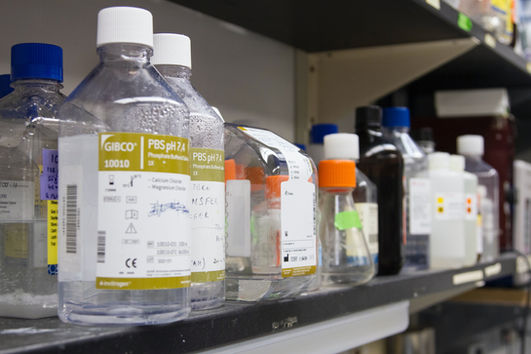

Chemical Assessments
Chemical Hazards are present when exposure occurs in a building structure in any form. Some chemicals don't pose much risk. Other chemicals, however, are extremely dangerous and can pose serious health risks and even death. The evaluation of their risks and properly and effectively addressing them is critical.
Once a property has been assessed and the analytical data has been received, TRUST Environmental Solutions will issue a comprehensive Chemical Assessment report to all relevant parties which includes the analytical findings, recommendations and a detailed scope of work for remediation.
Volatile Organic Compounds are compounds that vaporize (become a gas) at room temperature. This process is referred to as "off-gassing". VOCs are emitted as gases from certain solids or liquids and include a variety of chemicals, some of which may have short and long-term adverse health effects.
CHEMICAL ASSESSMENTS
Chemical Hazards are present when exposure occurs in a building structure in any form (solid, liquid or gas). Some chemicals are safer than others, but to those who are more sensitive, even common chemicals can cause illness, skin irritation, or breathing problems. Other chemicals, however, are extremely dangerous and can pose serious health risks and even death. The accurate identification of chemical hazards, the evaluation of their risks and properly addressing them is critical to ensure the health and safety of property occupants.



Common Chemical Compounds
TRUST Environmental Solutions has the capability to conduct thorough and comprehensive assessments for a wide array of chemicals ranging from common chemicals to the most rare chemical compounds such as:
-Volatile Organic Compounds (VOCs)-
VOCs, as defined by the U.S. Environmental Protection Agency (EPA), are "compounds that vaporize (become a gas) at room temperature." This process is referred to as "off-gassing" and includes a variety of chemicals, some of which may have short or long-term adverse health effects. Concentrations of many VOCs are consistently higher indoors (up to ten times) than outdoors. VOC testing methods commonly involves collecting air in an evacuated canister known as a Summa Canister. Samples are then analyzed by an accredited VOC testing laboratory to generate precise results.
Common Sources of VOCs:
-
Paints, paint strippers and other solvents
-
Wood preservatives
-
Aerosol sprays, cleansers, disinfectants and pesticides
-
Stored fuels and automotive products
-
Building materials and furnishings such as composite wood and laminate adhesives
-
Office or art materials such as adhesives, copier/printer ink and photographic solutions
-Formaldehyde-
Formaldehyde is a colorless, strong-smelling chemical. It occurs naturally in the environment, including in some foods and even inside our bodies, but it is also a widely used chemical in some industries and as a preservative in some products, such as antiseptics, medicines, and cosmetics. Relatively high amounts of Formaldehyde exposure has been shown to cause some types of cancer in humans.
Common Sources of Formaldehyde:
-
Pressed-wood products (plywood, particle board, paneling)
-
Foam insulation, wallpaper, paints and some synthetic fabrics
-
Glues, paints and coatings, lacquers and finishes
-
Some cosmetics and personal products
-Methamphetamine and Fentanyl Residue-
Fentanyl is a dangerous, powerful Schedule II narcotic responsible for an epidemic of deaths in the United States. Methamphetamine is a synthetic (man-made) stimulant that is highly addictive and dangerous. When Fentanyl or Methamphetamine is manufactured, or believed to have been manufactured, in an illicit operation using a “Clandestine Drug Laboratory” (an illegal drug laboratory), the property is considered to be a chemically contaminated property and unsafe for human occupancy until post decontamination sampling and analysis demonstrates the property is fit for use.
-Radon-
Radon is a radioactive gas that forms naturally when uranium, thorium, or radium break down in rocks, soil and groundwater. According to the Centers for Disease Control and Prevention, people can be exposed to radon primarily from breathing radon in air that comes through cracks and gaps in buildings and homes. When radon is inhaled, radioactive particles from radon gas can get trapped in your lungs and over time, these radioactive particles increase the risk of lung cancer.
-Marijuana / Cannabis Residue-
An Illicit Cannabis (marijuana) Grow Operation (known as “IMGO”) is where large crops of marijuana are grown illegally. The structural alterations/damage to the building can be extensive leaving the property in disrepair. These grow operations pose a risk of indoor air quality issues and potential health hazards such as mold exposure, pesticide contamination, and a significant amount of Biogenic Volatile Organic Compounds (BVOCs) exposure.
Elevated mold is caused by the warm, humid environment and the use of poorly plumbed water lines. The use of pesticides and fungicides can lead to pesticide contamination. However, the most significant issue is BVOC exposure due to the elevated Terpene concentration. Ambient measurements collected inside grow operations found terpene concentrations as high as 361 ppb which is approximately 170 times higher than the average outdoor terpene concentration of ~2 ppb. The high concentration of terpenes leaves significant residue on surfaces causes distinctive, lingering odorous air emissions which is very sticky and difficult to remove.
Comprehensive Chemical Assessments
Proper identification of chemical concentrations in buildings is essential to determine effective remedial activities. Once a property has been assessed and upon receipt of the analytical data, TRUST Environmental Solutions will issue a comprehensive Chemical Assessment report to all relevant parties which includes the analytical findings, recommendations and a detailed scope of work for remediation.







